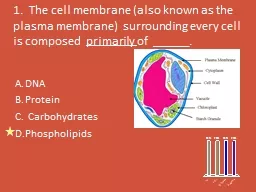

primarily of DNA Protein Carbohydrates Phospholipids 2 The phospholipids in the cell membrane are arranged in a bilayer double layer How are the phospholipid molecules arranged in this bilayer ID: 927989
Download Presentation The PPT/PDF document "1. The cell membrane (also known as the..." is the property of its rightful owner. Permission is granted to download and print the materials on this web site for personal, non-commercial use only, and to display it on your personal computer provided you do not modify the materials and that you retain all copyright notices contained in the materials. By downloading content from our website, you accept the terms of this agreement.
Slide1
1. The cell membrane (also known as the plasma membrane) surrounding every cell is composed primarily of ______.
DNAProtein CarbohydratesPhospholipids
Slide22. The phospholipids in the cell membrane are arranged in a bilayer (double layer). How are the phospholipid molecules arranged in this bilayer?
The nonpolar (hydrophobic) ends of the molecules faces inwardsThe polar (hydrophilic) ends of the molecules faces inwardsThe fatty acid tails of the molecules faces inwardBoth A and C
Both B and C
Slide3Channels through the phospholipid membrane are formed by
ProteinsDNACelluloseCholesterol
Slide43. The term permeability meansThe ability of a substance to bend
The ability of a substance to allow gases or liquids to pass throughThe ability of a substance to dissolveThe ability of a substance to exist for a long time with out deteriorating.
Slide54. In diffusion, molecules move from _________________ concentration in a process that __________________ additional energy.
high to low; requireshigh to low: does NOT requirelow to high; requireslow to high; does NOT require
Slide6Additional energy is not required, because diffusion occurs due to the random motion of the molecules
.
Slide75. A hypotonic solution is one that a
contains a higher concentration of solute particles contains an equal concentration of solute particles
contains a lower concentration of solute particles. is at a higher temperature is at a lower temperature
Slide8The prefix hypo means below or under. (To remember this, think of the word hypothermia which is when one’s body temperature drops below the normal body temperature.)
If the solute (such as salt or sugar) concentration outside is lower than that inside the cell, then the outside environment is hypotonic.
Slide9The prefix hyper means above or over.
If the solute (such as salt or sugar) concentration outside is higher than that inside the cell, then the outside environment is hypertonic.
Slide106. If a cell with a 0.2 M sucrose concentration inside is placed in a solution that has a 0.1 M sucrose concentration, the process of osmosis will occur. In this case,
sucrose will move into the cellsucrose will move out of the cellthe cell will expand due to water gain
the cell will shrink due to water lossboth A and Cboth B and D
Slide11Sucrose is disaccharide that is too large to move through the selectively permeable cell membrane. (Osmosis occurring means that it is the water moving through the membrane)
Hints to understanding the direction of movement of water in osmosis:
Remember that in passive transport (diffusion and osmosis) molecules always move from high concentrations to low concentration.However, solution concentrations are given in terms of the solute, but in osmosis it the water that moves through the membrane.To avoid getting confused by this, you can remember that if it has a higher solute concentration it will have a lower concentration of water. Examples: 3% sucrose solution is 97% water
8% sucrose solution is 92% water
3 %sucrose
(97% water)
8% salt
(92% water)
Slide127. If a cell with a 0.8% salt concentration inside is placed in a 0.9% salt solution,
the cell will shrink due to water loss salt will move out of the cell the cell will expand due to water gain
salt will move out of the cell both A and Dboth B and C
Slide13Salt is an ionic compound that can not move through the nonpolar barrier of the phospholipid membrane (without specialized channels).In osmosis, water will move in the direction of the higher SOLUTE concentration. Thus hypertonic solutions, such as one high in salt, causes cells to lose water.
Drinking salt water will dehydrate our cells Plants will wilt in a hypertonic solution.
Slide148. Which kind(s) of solution outside of a cell could cause it to swell and potentially lyse (burst open)?
a hypertonic solution a hypotonic solution an isotonic solution both A and C both B and C
Slide15Slide169. In an isotonic solution the cell swells
the cell shrinks there is NO movement of water in or out of the cell there is no NET movement of water
Slide17Water is constantly moving and diffusing through a cell membrane.
In an isotonic solution, the movement of water into the cell is equal to the movement of water out of the cell. There is a DYNAMIC EQUILIBRIUM.
Slide1810. When a substance is secreted from a cell in a process in which a vesicle fuses with the plasma membrane to released to the outside, it is called
endocytosisexocytosisosmosis
halitosis
Slide1911. O2 is a small, nonpolar molecule and it is present outside the cell in high concentration. It can
enterthe cell by Diffusion through the membrane
Passive transportActive transportA and B
A and C
Slide2012. Glucose is a larger polar molecule. If it is present outside of the cell in high concentration, it can enter the cell by
Facilitated diffusion through specialized channelsPassive transportActive transport
A and BA and C
Slide2113. An amino acid (a large polar molecule) is present outside the cell in low concentration. It can be brought into the cell by
Facilitated diffusion through specialized channelsPassive transportActive transport
A and BA and C
Slide22DDB
BCCAB
D BDD
C